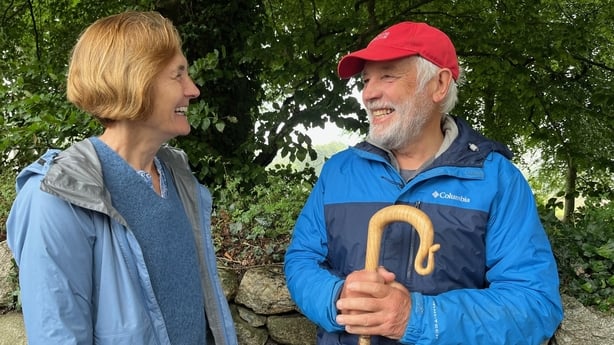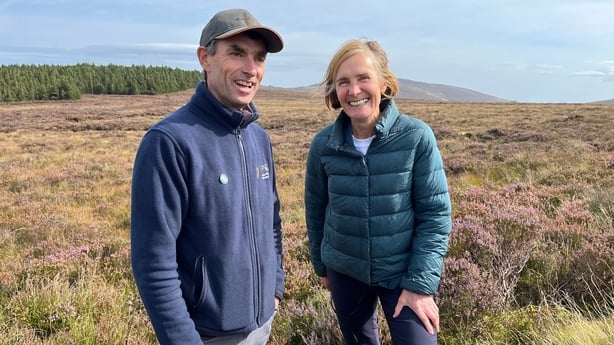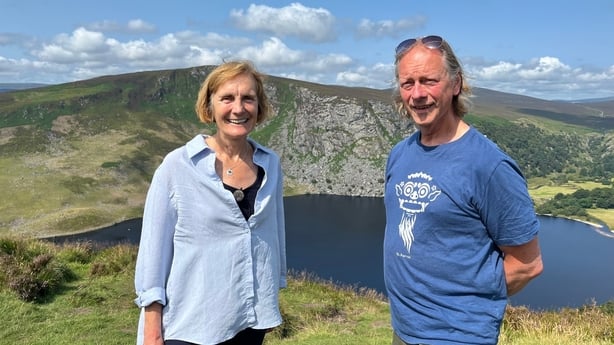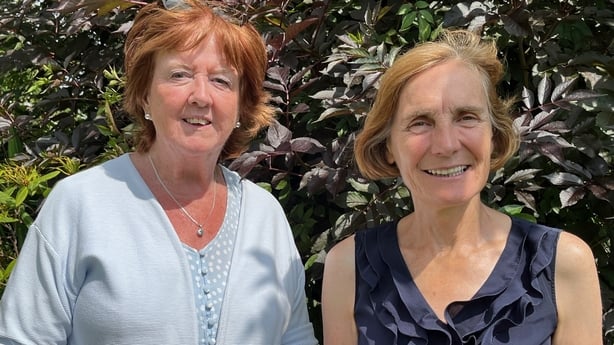On the Lyric Feature on Sunday 2nd February, at 6 pm, poet Jane Clarke presents Where the River Rises, exploring the Avonmore River in County Wicklow through poetry and conversation.
Below, Jane describes her relationship with the river...
Many Irish people have a river that is special to them.
When I was young that river was the Suck; a tributary of the Shannon, it flows alongside the farm where I grew up in County Roscommon. Since moving to Glenmalure thirty years ago I have fallen for the Avonmore. It is the largest river system in County Wicklow, stretching from its source in the mountains above Lough Tay into the three glaciated valleys of Glendasan, Glendalough and Glenmalure, and from there through Laragh, Clare Vale, Rathdrum, the Meetings of the Waters and Avoca to enter the sea at Arklow.
Over the years I have explored the streams, lakes and rivers of the Avonmore catchment as a hillwalker and swimmer and have found inspiration there for many poems.
When I first encountered the Avonmore I was struck by the ways in which it was different to the lowland, meandering Suck. In the uplands the water is extremely cold and oxygen-rich. The levels change rapidly with rainfall in the mountains and flash floods are frequent. There's the beauty of the exposed bedrock in boulder-strewn channels and the excitement of the riffle, cascade and pool sequences. The animals and plants that can survive this habitat are different to those found in the lowlands.

Whereas I was familiar with swans, mallards and coots along the Suck I had never even heard of a dipper when I first saw a white-breasted, plump bird bobbing up and down on a rock in the Avonmore. To my amazement it walked straight into and under the water. My friend, the ecologist Richard Nairn, explained that this unique bird is only found in the fast-flowing waters of mountain streams and rivers. It stays underwater while hunting stonefly and caddis fly larvae and its particularly high, piercing song is thought to have evolved in response to the loud flow of upland water.
The river catchment, also known as a watershed, is the land around a river that collects water from rainfall, mountains and bogs, channelling it into the river and its tributaries. I have come to understand that all the habitats in the catchment are interdependent; the health of one depends on the health of the others. Blanket bog forms a large part of the Avonmore catchment in the uplands. The swathes of bogland I know from hillwalking are severely degraded due to a combination of erosion, plantation forestry, burning and over-grazing, as well as climate change. As a result, the bog is emitting carbon into the atmosphere and sediment into the rivulets and streams that flow into the Avonmore.

One of our neighbours in Glenmalure, Hugh McLindon, is a Conservation Ranger with the National Parks & Wildlife Service. He leads a number of innovative peatland restoration projects in the Avonmore catchment and has brought me trudging uphill to see why the introduction of timber and hemp dams high in the mountains are crucial for maintaining the health of the river system and therefore our drinking water. He and others, including a regular group of volunteers from Mountaineering Ireland, are engaged in the mammoth task of saving one of our most vital habitats.
Wicklow is renowned above all for its trees. Whereas many other Irish rivers have been altered by arterial drainage, the Avonmore and its tributaries retain their original courses and therefore many of their natural riverside woodland habitats. I love the stretch of fragmented oak-wood along the Avonmore from Laragh as far as Avondale, including Clara Vale Nature Reserve. It's one of our few remaining areas of ancient forest; the area having been at least partially wooded since the Ice Age.
Though it is terribly degraded, there are efforts in train to protect and redevelop it. Another friend, ecologist Faith Wilson, is a founder of the East Wicklow Rivers Trust, which works to protect and improve water quality and biodiversity in the catchment. Faith stresses the interdependence of rivers and trees. Trees help filter water and alleviate flooding by slowing the flow. They prevent bank erosion and provide shelter and food for the birds, insects and small mammals that live on or near the river.

When walking the Avonmore catchment I often wonder about the people who lived here in the past and how the river influenced their lives. Close to the Sally Gap where the river runs out of Lough Tay towards Lough Dan, there’s a cluster of ruins and raised ridges. It’s fascinating to hear the archaeologist Chris Corlett speak about what these settlement remains can tell us about the lives of those who lived in this valley two hundred years ago.
The river passes many other historically significant places; the best known being the monastic settlement at Glendalough. One of my favourites is Avondale Estate, which is widely regarded as the spiritual home of Irish forestry. Wandering among sweet chestnuts, hornbeams, redwoods and Douglas fir, I always think of Anna Parnell who grew up in Avondale House. Her brother Charles Stewart was much better known, but her contribution to the Irish land war was immense. Surely growing up a stone’s throw from the Avonmore amongst those magnificent trees was part of her inspiration to work for land justice. It could well have led to her empathy with Irish people’s desire for independence as well as her own desire for freedom and independence as a young woman.
Our neighbour Jean Costelloe, former manager of Avondale Estate, has long taken an interest in the overlooked Parnell women, Anna, Fanny and their mother Delia. She gave me valuable information when I was researching their lives for a sequence of poems.

Given that nearly half of all rivers in Ireland are now below good ecological standards we are fortunate that the upper reaches of the Avonmore are relatively healthy. However, the sight of green algal bloom close to a renowned beauty spot, The Meetings of the Waters, indicates that we can’t take water quality for granted. I am grateful to the many people who are engaged in work to protect and restore this precious catchment. Their task must seem Sisyphean at times but nevertheless they persist for the sake of the river and for the sake of the generations to come who will walk in our footsteps on the banks of the Avonmore.
Listen to the Lyric Feature: Where the River Rises on RTÉ lyric fm on Sunday 2nd of February at 6pm, and listen to more from the Lyric Feature here or wherever you get your podcasts.

